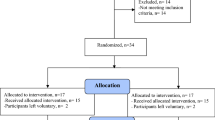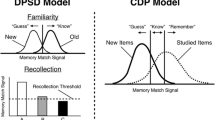Abstract
In the course of a 21-day Dry Immersion (DI), we studied the strength of Ponzo and Müller–Lyer visual illusions with the help of verbal response and two variants of the motor response by means of “tracking” (with the presence and absence of visual feedback). The studies were performed with the participation of ten subjects before the start of DI, on the 3rd, 10th, and 20th day of DI, as well as at the end of it. It was shown that DI mainly affects the motor response. Changes in reducing the strength of visual illusions were more pronounced for a more complex motor task performed in the absence of visual feedback. The results are in agreement with the data that we previously obtained under the conditions of a 5-day DI. One of the possible mechanisms of the observed changes in the illusions estimates may be hyperactivation of the dorsal visual pathway due to gravitational unloading.




Similar content being viewed by others
REFERENCES
Velichkovskii, B.M., Kognitivnaya nauka: Osnovy psikhologii poznaniya (Cognitive Science: Fundamentals of the Psychology of Cognition), in 2 vols., Moscow: Smysl, 2006, p. 162.
Suzuki, Y., Fujii, K., and Onizawa, T., Studies on sensory deprivation: IV. Part 6: Effects of sensory deprivation upon perceptual function, Tohoku Psychol. Folia, 1965, vol. 24, p. 24.
Lybrand, W.A., Andrews, T.G., and Ross, S., Systemic fatigue and perceptual organization, Am. J. Psychol., 1954, vol. 67, no. 4, p. 704.
King, J.P., Christensen, B.K., and Westwood, D.A., Grasping behavior in schizophrenia suggests selective impairment in the dorsal visual pathway, J. Abnorm. Psychol., 2008, vol. 117, no. 4, p. 799.
King, D.J., Hodgekins, J., Chouinard, P.A., et al., A review of abnormalities in the perception of visual illusions in schizophrenia, Psychon. Bull. Rev., 2017, vol. 24, no. 3, p. 734.
Grzeczkowski, L., Roinishvili, M.O., Chkonia, E.D., et al., Is the perception of illusions abnormal in schizophrenia? Psychiatry Res., 2018, vol. 270, p. 929.
Gori, S., Molteni, M., and Facoetti, A., Visual illusions: an interesting tool to investigate developmental dyslexia and autism spectrum disorder, Front. Hum. Neurosci., 2016, vol. 10, p. 175.
Giese, M.A. and Rizzolatti, G., Neural and computational mechanisms of action processing: Interaction between visual and motor representations, Neuron, 2015, vol. 88, no. 1, p. 167.
Dokka, K., DeAngelis, G.C., and Angelaki, D.E., Multisensory integration of visual and vestibular signals improves heading discrimination in the presence of a moving object, J. Neurosci., 2015, vol. 35, no. 40, p. 13599.
Grabherr, L. and Mast, F.W., Effects of microgravity on cognition: the case of mental imagery, J. Vestibular Res., 2010, vol. 20, no. 1, p. 53.
Tomilovskaya, E., Shigueva, T., Sayenko, D., Rukavishnikov, I., and Kozlovskaya, I., Dry immersion as a ground-based model of microgravity physiological effects, Front. Physiol., 2019, vol. 10, p. 284.
Sosnina, I.S., Lyakhovetskii, V.A., Zelenskiy, K.A., Karpinskaya, V.Yu., and Tomilovskaya, E.S., Effects of five-day “dry” immersion on the strength of the Ponzo and the Müller–Lyer illusions, Neurosci. Behav. Physiol., 2019, vol. 49, no. 2, p. 847.
Cheron, G., Leroy, A., Palmero-Soler, E., et al., Gravity influences top-down signals in visual processing, PLoS One, 2014, vol. 9, no. 1, p. e82371.
Shoshina, I.I., Sosnina, I.S., Zelenskiy, K.A., et al., The functional state of the magnocellular and parvocellular neuronal systems in microgravity conditions, Materialy Pyatnadtsatogo mezhdunarodnogo mezhdistsiplinarnogo kongressa “Neironauka dlya meditsiny i psikhologii,” Sudak, 30 maya–10 iyunya 2019 g. (Proc. Fifteenth Int. Interdisciplinary Congr. “Neuroscience for Medicine and Psychology,” Sudak, May 30–June 10, 2019), Sudak, 2019, p. 474.
Oldfield, R.C., The assessment and analysis of handedness: the Edinburgh inventory, Neuropsychologia, 1971, vol. 9, p. 97.
Aarts, E., Verhage, M., Veenvliet, J.V., et al., A solution to dependency: using multilevel analysis to accommodate nested data, Nat. Neurosci., 2014, vol. 17, p. 491.
Chetverikov, A.A., Linear models with mixed effects in cognitive researches, Ross. Zh. Kognit. Nauki, 2015, vol. 2, no. 1, p. 41.
Karpinskaya, V. and Lyakhovetskii, V., Differences in sensorimotor assessment of Ponzo’s and Müller–Lyer’s illusions, Psikhol. Issled., 2014, vol. 7, no. 38, p. 3.
Martín-Loeches, M., Valdés, B., Gómez-Jarabo, G., and Rubia, F.J., Working memory within the visual dorsal stream: brain potentials of spatial location and motion direction encoding into memory, Int. J. Neurosci., 1998, vol. 96, nos. 1–2, p. 87.
Searleman, A., Porac, C., Alvin, J., and Peaslee, K., Manipulating the strength of the Ponzo and horizontal–vertical illusions through extraction of local cue information, Am. J. Psychol., 2009, vol. 122, no. 3, p. 383.
Pechenkova, E., Nosikova, I., Rumshiskaya, A., et al., Alterations of functional brain connectivity after long-duration spaceflight as revealed by fMRI, Front. Physiol., 2019, vol. 10, p. 761.
Dijkerman, H.C. and de Haan, E.H., Somatosensory processes subserving perception and action, Behav. Brain Sci., 2007, vol. 30, no. 2, p. 189.
Husain, M. and Nachev, P., Space and the parietal cortex, Trends Cognit. Sci., 2007, vol. 1, no. 11, p. 30.
Kornilova, L.N. and Tarasov, I.K., Orientation illusions in weightlessness, Aviakosm. Ekol. Med., 1996, vol. 30, no. 3, p. 17.
Kornilova, L.N., Glukhikh, D.O., Habarova, E.V., et al., Visual–manual tracking after long spaceflights, Hum. Physiol., 2016, vol. 42, no. 3, p. 301.
Kornilova, L.N., Naumov, I.A., Mazurenko, A.Yu., and Kozlovskaya, I.B., Visual-manual tracking and vestibular function during a seven-day dry immersion, Hum. Physiol., 2010, vol. 36, no. 7, p. 813.
Jang, S.H. and Jang, W.H., The different association of allocentric and egocentric neglect with dorsal and ventral pathways: a case report, Medicine (Baltimore), 2018, vol. 97, no. 37, p. e12394.
Men’shikova, G.Ya., Constructive and ecological approaches to the study of the visual perception: analysis of differences, Vestn. Mosk. Univ., Ser. 14: Psikhol., 2007, vol. 4, p. 34.
Badakva, A.M., Miller, N.V., Zobova, L.N., and Roshchin, V.Yu., The influence of support unloading on the cortical control of hand movements in immersion experiments on monkeys, Aviakosm. Ekol. Med., 2019, vol. 53, no. 3, p. 33.
McIntyre, J. and Lipshits, M., Central processes amplify and transform anisotropies of the visual system in a test of visual–haptic coordination, J. Neurosci., 2008, vol. 28, no. 5, p. 1246.
Funding
The development of methods for assessing illusions and data analysis was carried out with the support of the Russian Foundation for Basic Research (project no. 19-013-00036). Organization of immersion studies and participation of E.S. Tomilovskaya were supported by the RAS project (63.1).
Author information
Authors and Affiliations
Corresponding author
Ethics declarations
COMPLIANCE WITH ETHICAL STANDARDS
All studies were carried out in accordance with the principles of biomedical ethics formulated in the 1964 Declaration of Helsinki and its subsequent updates, and approved by the local bioethical committee of the Institute for Biomedical Problems RAS (Moscow).
CONFLICT OF INTEREST
The authors declare no obvious and potential conflicts of interest related to the publication of this article.
INFORMED CONSENT
Each the study participant submitted a voluntary written informed consent signed by him after explaining to him the potential risks and benefits, as well as the nature of the upcoming study.
Rights and permissions
About this article
Cite this article
Sosnina, I.S., Lyakhovetskii, V.A., Zelenskiy, K.A. et al. The Effect of a 21-Day Dry Immersion on Ponzo and Müller–Lyer Illusions. Hum Physiol 47, 51–59 (2021). https://doi.org/10.1134/S0362119721010138
Received:
Revised:
Accepted:
Published:
Issue Date:
DOI: https://doi.org/10.1134/S0362119721010138




